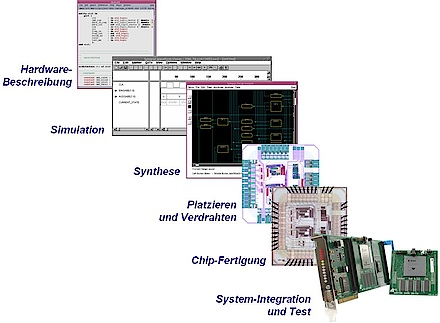Basics of the VLSI design
Event no:
L.048.11007
Event type:
Lecture V2, Exercise Ü2 (Lecture language German)
Credit points:
6
Time and place:
For information on the venue and time of the event, please refer to PAUL
Brief description
Complex digital circuits with several hundred thousand transistors (e.g. microcontrollers) and up to several billion transistors (e.g. graphics processors) can be found in almost every technical device today. They are known as VLSI circuits (VLSI = abbreviation for Very-Large-Scale Integrated Circuit). The lecture Fundamentals of VLSI Design covers the basics of designing and testing complex integrated digital circuits based on modern semiconductor technologies and design methods.
The lecture will be held for the first time in the winter semester 2015/2016 and replaces the previous lecture Design of Microelectronic Systems.
Contents:
Topics of the lecture are:
- VLSI design methodology and IC design styles
- CMOS technology, CMOS logic gates, design and switching behaviour of CMOS gates
- On-chip wiring and influence on switching behaviour
- Design of sequential switching devices
- Power loss and power loss reduction
- Clock system and IO circuits
- Test-friendly design
- The exercises cover the two most important design styles for digital integrated circuits. On the one hand, the design of reconfigurable digital circuits based on field-programmable gate arrays (FPGAs) is practised with practical design problems. On the other hand, a digital circuit is developed using standard cell design as an example. The exercise is carried out using modern design software from Xilinx and Cadence Design Systems, which is also used in an industrial environment.

